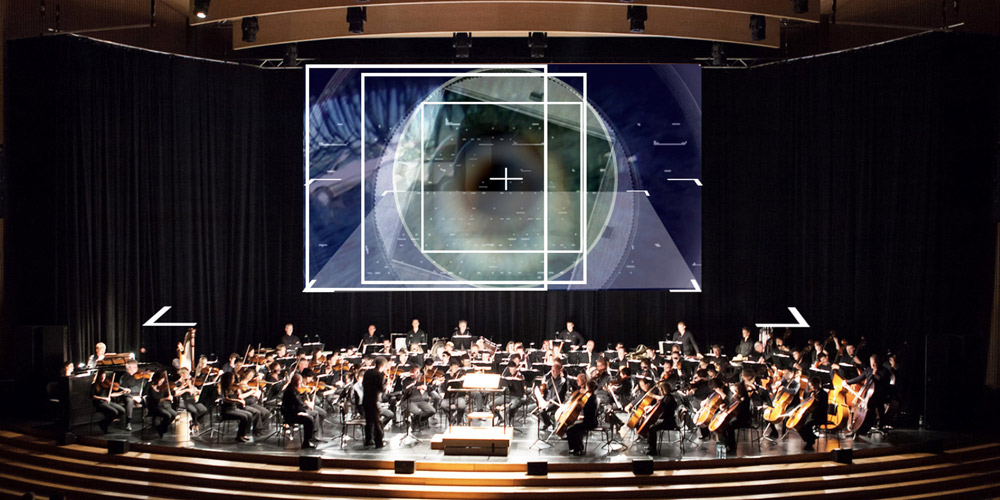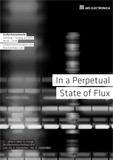SUN September 7, 2014, 7 PM - 7:45 PM, LENTOS Kunstmuseum Linz, Auditorium
SUN September 7, 2014, 8 PM - Midnight, Brucknerhaus, Großer Saal
Please note
Due to family issues Michael Nyman could not be part of the final rehearsal work in Linz. As the expected quality cannot be guaranteed, Symphony Nr. 3 – Symphony of Sexual Songs will not be performed in the scope of Big Concert Night 2014. We are already working on to premiere the piece in the year 2015.
Orchestral music and digital sounds on one end of the spectrum; live electronics and visualizations on the other—since 2002, these have been the programmatic antipodes of the Big Concert Night staged by the Ars Electronica Festival, Brucknerhaus Linz and Bruckner Orchester Linz.
Breathing Drums
Kicking things off this year in the LENTOS Art Museum’s auditorium is “Trommeln ist ein Dehnbarer Begriff” (Drumming is an Elastic Concept), Josef Klammer’s (AT) scenic solo concert for percussion instruments and electronics. Klammer has replaced his drums’ conventional plastic drumheads with ones made of rubber, which retards and extends the drumbeats and makes the drums’ “breathing” audible.
Warlike Music
Next is a performance by the Bruckner Orchester Linz (AT) conducted by Dennis Russell Davies (US / AT) of Philip Glass’ “Overture for 2012.” The work with martial percussion passages was commissioned to mark the 200th anniversary of what Americans call the War of 1812. In musical history, it takes its place alongside a very famous work: the “1812 Overture” by Pyotr Ilyich Tchaikovsky commemorating Russia’s defeat of Napoleon at the Battle of Borodino.
Two Chimeras
“Les Chimères” is the first work that’s ever been commissioned by Bruckner Orchester Linz and the Province of Upper Austria expressly for the Ars Electronica Festival’s Big Concert Night.
Composer Marco Lemke prefers to work with classical music formats, to which he adds new sounds. The visualization custom-designed to accompany his work, “Everything We See Could Also Be Otherwise” by Arotin & Serghei (AT/RU), is dedicated to philosopher Ludwig Wittgenstein. It’s a live animation of their “Infinite Screen” installation. The material they used for it includes iris scans, flying cells from the Ars Electronica BioLab, images of the particle accelerator at CERN and the grotesque faces of gargoyles on the façade of Notre-Dame-de-Paris.
Artifacts and Sexual Songs
The orchestra and Conductor Davies then segue from chimeras to “Artefacts,” Julia E. Howell’s three-part piece based on personal recordings—for instance, a fiddle concert featuring members of her family and a Mardi Gras procession in New Orleans. The visualizations are by Remo Rauscher (AT), an up-and-coming young visual artist and filmmaker from Upper Austria.
Then things get steamy: Michel Nyman’s (UK) “Symphony No. 3” with the erotic epithet Symphony of Sexual Songs. The world premiere of Nymans work will be accompanied by a film entitled “The Art of Fugue.” This allusion to Bach is an uncut 28-minute sequence Nyman shot near his residence in Mexico City.
Machine Voices
Rutger Zuydervelt (NL) of Machinefabriek will present installations especially adapted for this concert. “Stay Tuned” is a slowly unfolding composition of 150 recordings of the concert pitch A made by an equal number of musicians who then contributed them to the piece. “Stadsverwarring,” originally created as the soundtrack for a thermal power station, takes listeners on an acoustic journey into the heart of the noisy machinery at work there.
Pioneers of Electronic Music
With three video intermezzi, the Big Concert Night commemorates three pioneers of electronic music active in the 1960s: “Falling” (1964) with “Invention for Radio No.1” by Delia Derbyshire (UK) and Barry Bermange (UK), “fordømmelse” (1962) by Else Marie Pade (DK), and “Four Aspects” by Daphne Oram (UK).


